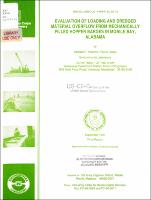Please use this identifier to cite or link to this item:
https://hdl.handle.net/11681/21082| Title: | Evaluation of loading and dredged material overflow from mechanically filled hopper barges in Mobile Bay, Alabama |
| Authors: | Palermo, Michael R. Zappi, Paul A. |
| Keywords: | Dredging--Alabama--Mobile Bay Dredging spoil--Alabama--Mobile Bay Dredged material Dredges Barges |
| Publisher: | Environmental Laboratory (U.S.) |
| Series/Report no.: | Miscellaneous Paper;EL-90-16 |
| Abstract: | Abstract: Authorizing legislation for the deepening of navigation channels in Mobile Bay specifies that the new work dredged material and material from future maintenance dredging must be placed in an approved open-water disposal site in the Gulf of Mexico. Large mechanical dredges with clamshell buckets are being used for the new-work dredging. Hopper barges are loaded with the dredged material and transported by tug to the disposal site. Mechanical dredging is also the most likely technique for future maintenance. The economic loading of the hopper barges and the potential environmental impact associated with barge overflow during loading are important issues. A field study was therefore conducted to give site-specific information on the loading gains achieved by overflow and the characteristics of the overflow for conditions in Mobile Bay. The field study included data collection on dredge-operating characteristics, sampling and testing of material comprising the barge overflow, and monitoring the loading characteristics of the barges. The dredge CHICAGO (equipped with a 30-yd³ clamshell bucket) and 6,000-yd³ hopper barges were used during the study. Loads gained during three overflow tests were 4.1, 1.2, and 11.5 percent for overflow periods of 60, 24, and 65 minutes. For all three tests, the overflow ended with a significant amount of diluted slurry ponded in the barges, indicating that additional load gains would be possible with prolonged periods of overflow. The solids concentrations of bucket material samples averaged 1,080 g/L, while that of the overflow was essentially constant for the entire period of overflow and averaged 80 g/L. The results indicate that retention of solids in the hopper barges occurs during the overflow process for mechanical dredging. The grain size analysis of overflow samples showed a larger fraction of finer material than that for bucket samples, with average grain sizes of 0.012 mm for overflow and 0.12 mm for bucket material, indicating that sorting of grain sizes occurs in the hopper barges during barge overflow using mechanical dredging techniques. |
| URI: | http://hdl.handle.net/11681/21082 |
| Appears in Collections: | Miscellaneous Paper |
Files in This Item:
| File | Description | Size | Format | |
|---|---|---|---|---|
| MP EL-90-16.pdf | 2.98 MB | Adobe PDF |  View/Open |